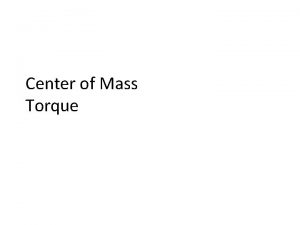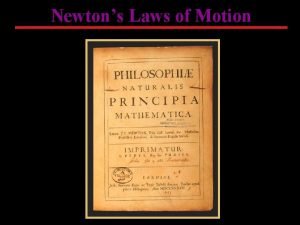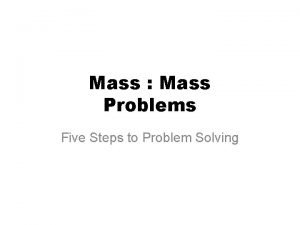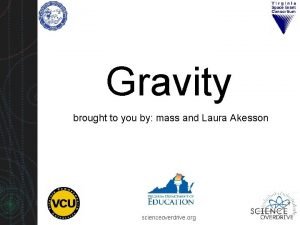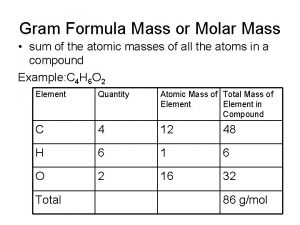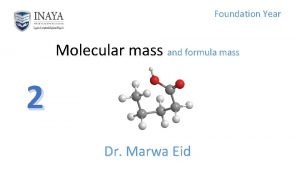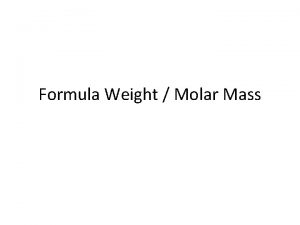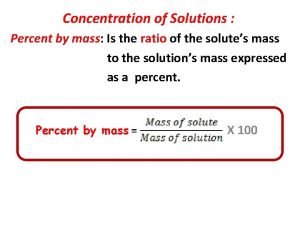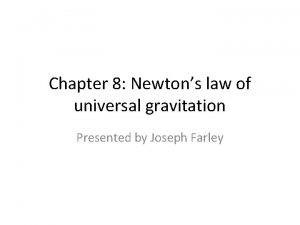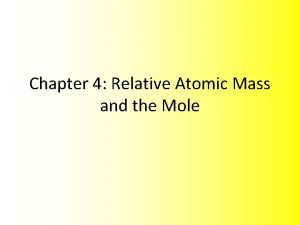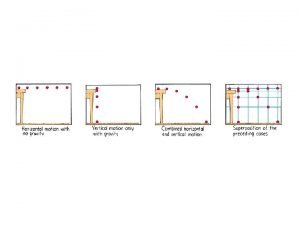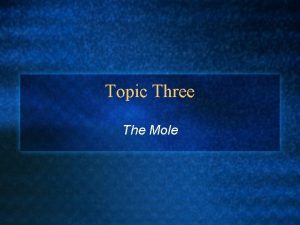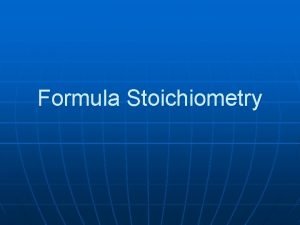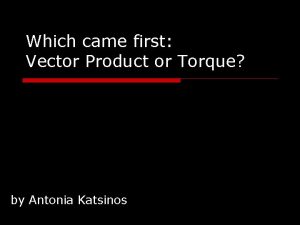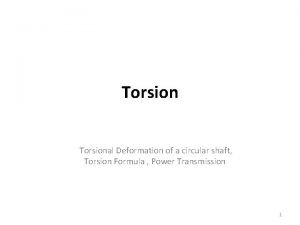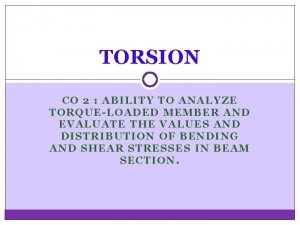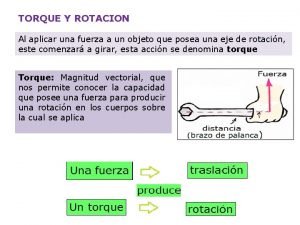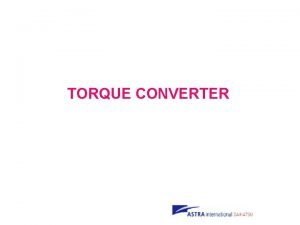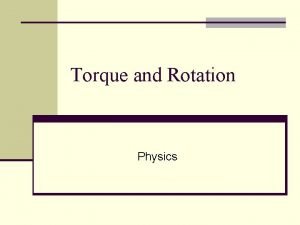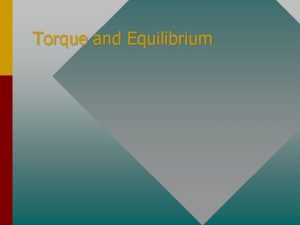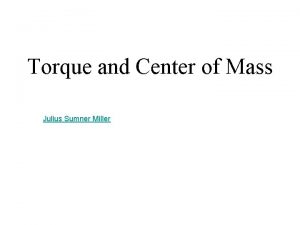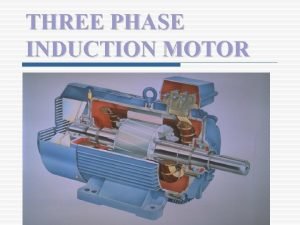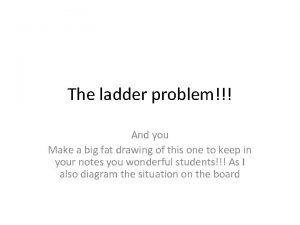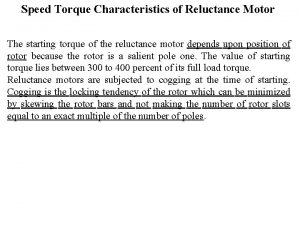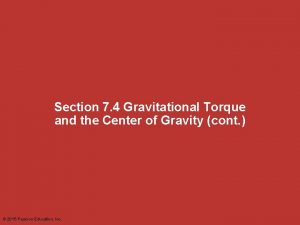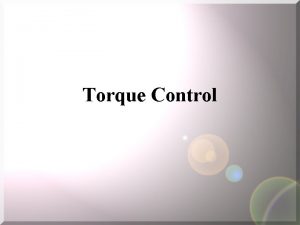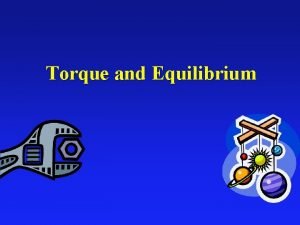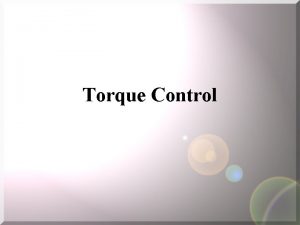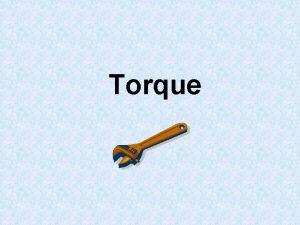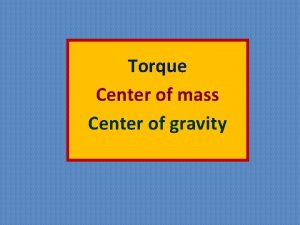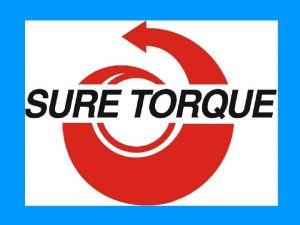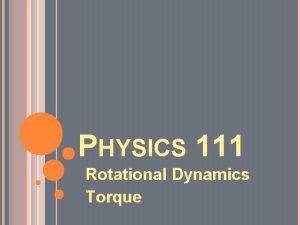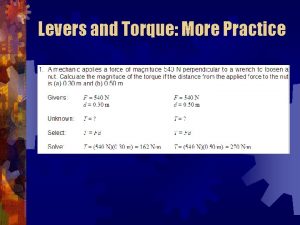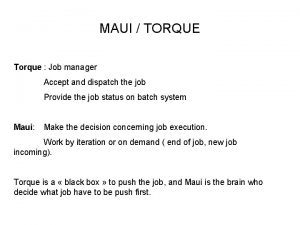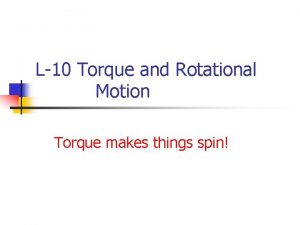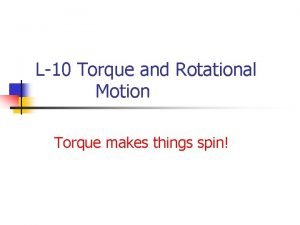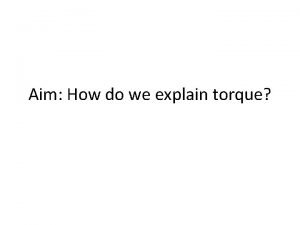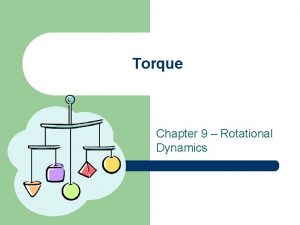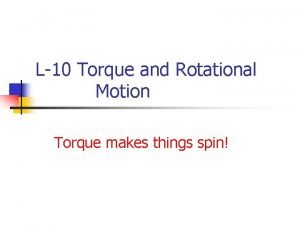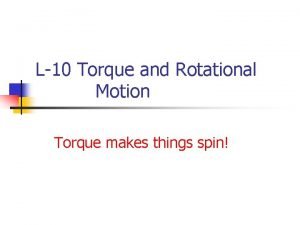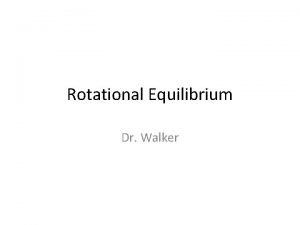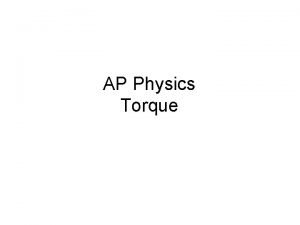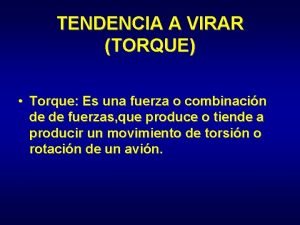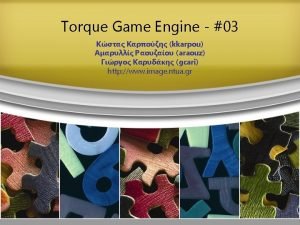Center of Mass Torque Center of Mass When








































- Slides: 40

Center of Mass Torque

Center of Mass When analyzing the motion of an extended object, we treat the entire object as if its mass were contained in a single point, known as the object’s center of mass (CM). Mathematically, the CM of an object is the weighted average of the location of the mass in an object.

7 -8 Center of Mass In (a), the diver’s motion is pure translation; in (b) it is translation plus rotation. There is one point that moves in the same path a particle would take if subjected to the same force as the diver. This point is the center of mass (CM).

7 -8 Center of Mass The general motion of an object can be considered as the sum of the translational motion of the CM, plus rotational, vibrational, or other forms of motion about the CM.

7 -8 Center of Mass The center of gravity is the point where the gravitational force can be considered to act. It is the same as the center of mass as long as the gravitational force does not vary among different parts of the object.

7 -8 Center of Mass The center of gravity can be found experimentally by suspending an object from different points. The CM need not be within the actual object – a doughnut’s CM is in the center of the hole.

Locating Center of Mass • Center of mass can be “outside” an object.

7 -9 CM for the Human Body The x’s in the small diagram mark the CM of the listed body segments.

7 -9 CM for the Human Body The location of the center of mass of the leg (circled) will depend on the position of the leg.

7 -9 CM for the Human Body High jumpers have developed a technique where their CM actually passes under the bar as they go over it. This allows them to clear higher bars.

7 -10 Center of Mass and Translational Motion The total momentum of a system of particles is equal to the product of the total mass and the velocity of the center of mass. The sum of all the forces acting on a system is equal to the total mass of the system multiplied by the acceleration of the center of mass: (7 -11)

7 -10 Center of Mass and Translational Motion This is particularly useful in the analysis of separations and explosions; the center of mass (which may not correspond to the position of any particle) continues to move according to the net force.

CM of Two Particles For two masses on a frictionless bar, where is the center of mass?

7 -8 Center of Mass For two particles, the center of mass lies closer to the one with the most mass: where M is the total mass.

General Formulas for CM M is total mass of system

Example • m 1=5 kg is located at x=10 m from origin • m 2=10 kg is located at x=16 m from origin

Do Now • Find the center of mass of a system two masses if a 2 kg mass is located at x=0 and a 3 kg mass is located at x=10 m. 2 kg 3 kg

Torque To make an object start rotating, a force is needed. If you push at the edge of the door with a force perpendicular to the door, the door rotates around the axes that passes through the hinge. The ability of a force to rotate an object around some axis is measured by a quantity called a torque.

8 -4 Torque The position and direction of the force that creates rotation is very important. The perpendicular distance from the axis of rotation to the line along which the force acts is called the lever arm.

Lever Arm • To get the maximum torque, the force should be applied in a direction that creates the greatest lever arm.

8 -4 Torque Here, the lever arm for FA is the distance from the knob to the hinge; the lever arm for FD is zero; and the lever arm for FC is as shown.

Rate the forces using scale 1 -3 according to their effectiveness in turning the nut? (1 -most effective, 3 - least effective).

8 -4 Torque A longer lever arm is very helpful in rotating objects.




Torque τ= Frsinθ r – distance from the axis of rotation to the point of the application of the force The symbol for torque is Greek letter tau SI unit of torque is N • m Newton-meter

Bar With Pivot The bar is balanced if the net torque =0 Pivot Weight of bar =20 N Acts as if it was at the center of mass. What force should be applied at x to balance the torque? The length of the bar = 2 m.


The Sign of a Torque • Torque is a vector. • If a positive torque is applied, the object will start rotating in a counter-clockwise direction. • Negative torque produces clockwise rotation. Positive torque Negative torque

Balanced Torques • Balance is achieved if the torque that tends to produce clockwise rotation by the boy equals the torque that tends to produce counterclockwise rotation by the girl.

Balanced Torques 20 N 1 m 0. 5 m

Balanced Torques • If the total torque on a motionless object is zero, the object will be balanced and not start rotating. • Thus the sum of all torques on an object at equilibrium must be zero.

Balanced Torques 20 N 1 m 0. 5 m Left torque = 10 N x 1 m = 10 N m Right torque = 20 N x 0. 5 m = - 10 N m

Rotational Equilibrium • When an object is in rotational equilibrium, the total torque applied to it is zero. • Rotational equilibrium is often used to determine unknown forces.

What mass must be added to balance the scale? • Find the force that balances the torque 4 m 2 kg 2 m 5 m 1 kg ? kg

Example • Find the force that balances the torque 2 m 10 N 5 m ? N

Example • A boy and his cat sit on a seesaw. The cat has a mass of 4 kg and sits 2 m from the center of rotation. If the boy has a mass of 50 kg, where should he sit so that the see-saw will balance?

Questions: 1) What is torque? 2)How do we calculate torque? 3) What are the units of measurement of torque? 4) What is rotational equilibrium?

Practice Problem • What is the torque on a bolt applied with a wrench that has a lever arm of 45 cm with a force of 10 N? • Torque = F x r = (10 N)(0. 45 m) = 4. 5 N m
 What is the lever arm in torque
What is the lever arm in torque Ideal stoichiometric calculations
Ideal stoichiometric calculations Representation of atomic number and mass number
Representation of atomic number and mass number Relative formula mass of hcl
Relative formula mass of hcl How to find mass percentage
How to find mass percentage Inertial mass vs gravitational mass
Inertial mass vs gravitational mass Grams to mol
Grams to mol Molar mass unit
Molar mass unit Molar mass def
Molar mass def Converting grams to moles
Converting grams to moles How to find mol from mass
How to find mol from mass Mass/mass problems
Mass/mass problems Differentiate between atomic number and mass number
Differentiate between atomic number and mass number Gravitational mass vs inertial mass
Gravitational mass vs inertial mass Molar mass table
Molar mass table Formula mass vs molecular mass
Formula mass vs molecular mass Formula mass vs molecular mass
Formula mass vs molecular mass Mass number formula
Mass number formula How to get percent concentration
How to get percent concentration Inertial mass vs gravitational mass
Inertial mass vs gravitational mass Co2 relative molecular mass
Co2 relative molecular mass How to calculate abundance of isotopes
How to calculate abundance of isotopes Atomic mass vs molar mass
Atomic mass vs molar mass Stoichiometry worksheet #2 (mole-mass mass-mole problems)
Stoichiometry worksheet #2 (mole-mass mass-mole problems) N n avogadro
N n avogadro A car of mass 1200kg pulls a trailer of mass 400kg
A car of mass 1200kg pulls a trailer of mass 400kg Formula mass vs gram formula mass
Formula mass vs gram formula mass Formula mass vs gram formula mass
Formula mass vs gram formula mass Cold air mass overtakes warm air mass
Cold air mass overtakes warm air mass Right hand rule torque
Right hand rule torque Circular shaft formula
Circular shaft formula Torque on shaft formula
Torque on shaft formula Torque
Torque Fungsi one way clutch
Fungsi one way clutch Lever arm physics
Lever arm physics How to calculate resultant torque
How to calculate resultant torque Net torque formula
Net torque formula How to test a 3 phase motor
How to test a 3 phase motor Ladder problem
Ladder problem Torque speed characteristics of switched reluctance motor
Torque speed characteristics of switched reluctance motor Gravitational torque
Gravitational torque
